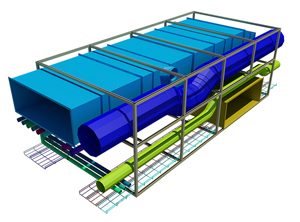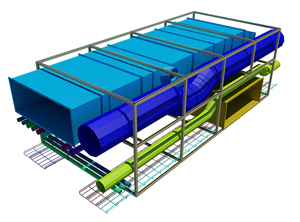How is BIM Revolutionising the Construction Industry?
BIM, or Building Information Modelling, is the buzzword within construction at the moment as the British Government’s deadline for all public works contractors to be ‘BIM ready’ has now passed. As a company who offer BIM Services, we have ensured that all our clients now comply with the technical elements relating to BIM Level 2 (the basic collaborative level of BIM which allows all of the people involved in a project to share information using common file formats). The deadline for BIM level 2 compliance was introduced by the British Government in an attempt to encourage more efficiencies within all stages of the construction lifecycle.
The adoption of BIM in the UK, and indeed the world, is hardly surprising when you look at the many benefits of BIM – whatever level of implementation you are at. We know from experience that even if you only use BIM for your models, for example, you will still see a dramatic reduction in errors and your models will also be completed in a shorter amount of time than usual. BIM has turned out to be a tool which can provide more accurate and more consistent documents in a shorter time-frame, and also encourages better collaboration and coordination among all of the parties involved in the project.

It is not all bright lights, though, as with any new technology there is a learning curve for all involved, and BIM implementation is not without its challenges. One common problem is that users tend to think of BIM as a piece of software rather than an actual process, with some project managers even viewing it as a separate function of the business. Another challenge is that there seems to be a wide variation in the quality of BIM models produced, with companies working at different levels and lacking in validation.
Collaboration can also be difficult to achieve as the question of where you put the data so that everyone can access it and that it is responsive, is a hard one to tackle. Many project managers centralise it, but this can make it painfully slow for remote users to open the files they need. As with any new technology, adoption can feel slightly overwhelming, so we would recommend a gradual implementation in order to lessen the growing pains. A slower pace will also help new users to ease themselves in gradually, instead of resorting to throwing their hands up in despair and resorting back the old processes they know.
The adoption of BIM should be seen as a change in culture rather than just a change in technology, as the successful implementation of BIM requires not only upper management buy-in but a spirit of collaboration and expectations of continuous improvement. One great way to do this is to use BIM for a small project, to begin with, so that everyone can get a feel for it and it can be a springboard for your company to develop its BIM capabilities.
There is value for every business in the implementation of BIM, and we can help you with that. For more information on our BIM Services, and how we can help you achieve Level 2 BIM, please call us on 0161 427 0348 or send us an email to office@thecadroom.com

